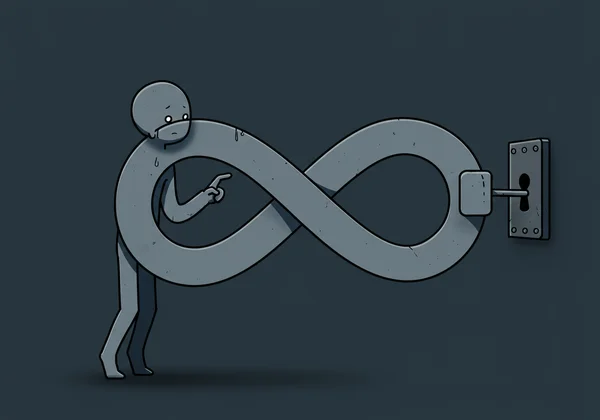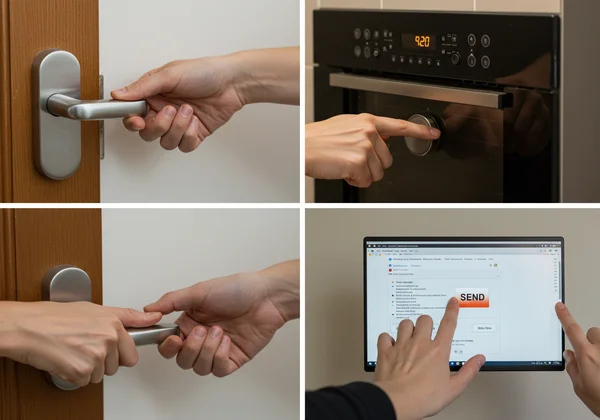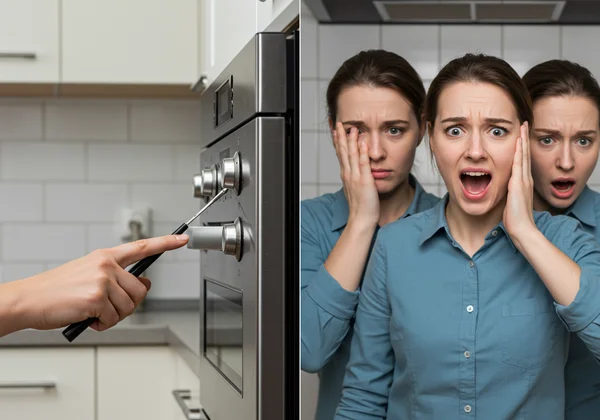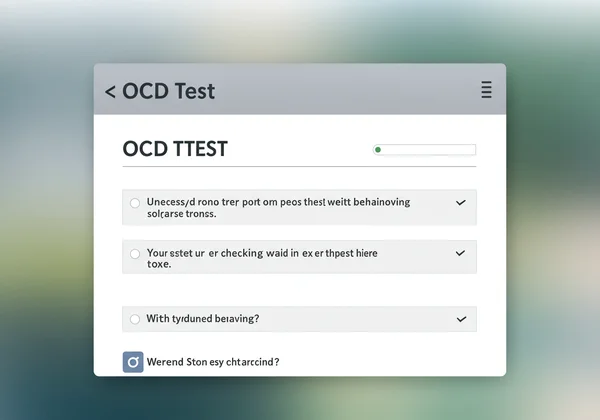Checking OCD Test: Stuck in Obsessive Checking Loops?
Are you constantly re-checking locks, stoves, or emails, even when a part of your brain knows you've already done it? This persistent urge to check and re-check, often driven by an overwhelming sense of dread or doubt, can be more than just a quirky habit. It can be a hallmark of Checking OCD, a specific subtype of Obsessive-Compulsive Disorder. If you're asking yourself, Do I have OCD test?, you've come to the right place for clarity.
This guide will explore what separates carefulness from compulsion, how obsessive checking impacts daily life, and how you can take a safe, confidential first step towards understanding your behaviors. Understanding starts with a single question, and a reliable OCD screening tool can offer initial answers.
Understanding Obsessive Checking: More Than Just Being Careful
At its core, checking is a normal and even helpful human behavior. We double-check that the oven is off before leaving the house to prevent a fire. However, for someone with Checking OCD, this behavior transforms from a sensible precaution into a draining, time-consuming ritual that offers little to no lasting peace of mind.
What is Obsessive Checking? Defining the Cycle
Obsessive checking is characterized by a relentless cycle. It begins with an intrusive, unwanted thought, image, or urge (the obsession), such as a terrifying mental picture of the house burning down. This obsession creates intense anxiety and distress. To neutralize this anxiety, you feel an overwhelming compulsion to perform a checking ritual.
Completing the check provides a fleeting moment of relief. But soon, doubt creeps back in. "Did I check it properly?" "What if I missed something?" The uncertainty fuels the anxiety, and the cycle begins all over again, often with each check becoming more elaborate and time-consuming. This pattern is not about being meticulous; it's about being trapped by doubt.

Common Obsessions Driving Checking Behaviors
The compulsive checking is not random; it is directly linked to an underlying obsession or fear. These obsessions often revolve around themes of preventing harm, avoiding mistakes, or maintaining a sense of certainty.
Common obsessions include:
- Fear of Harming Others: An intense worry that your negligence will cause a catastrophe, like starting a fire, causing a flood, or hitting someone with your car.
- Fear of Harming Yourself: A persistent concern that you’ve left yourself vulnerable to danger, such as by not locking the door or leaving a window open.
- Fear of Making a Mistake: Dread over sending an email with a typo, submitting flawed work, or saying something inappropriate, leading to social or professional ruin.
- Fear of Losing Important Items: An irrational worry about misplacing critical documents, keys, or wallets.
The Compulsive Actions: Examples You Might Recognize
These deep-seated fears manifest as tangible, repetitive actions. While specific compulsions vary, many common checking behaviors are widely recognized, and many people find these patterns resonate deeply with their experiences.
You might recognize behaviors like:
- Repeatedly checking that doors and windows are locked.
- Constantly verifying that appliances like stoves, irons, and faucets are turned off.
- Driving back to check if you've caused an accident.
- Endlessly re-reading emails and texts before or after sending them to ensure there are no errors.
- Frequently checking your body for signs of illness.
- Seeking reassurance from others, asking questions like, "Are you sure I locked the door?"
If these examples feel familiar, taking a confidential assessment could be a valuable step in understanding them better.

Normal Vigilance vs. Compulsive Checking Disorder
Everyone double-checks things from time to time. So, where is the line between being a responsible person and having what could be described as a compulsive checking disorder? The distinction lies in the function and impact of the behavior.
Normal checking is goal-oriented and provides lasting reassurance. You check the stove, confirm it's off, and leave the house feeling secure. Compulsive checking, however, is driven by anxiety and provides only temporary relief. The doubt returns almost immediately, demanding another check.
When Does Double-Checking Become a Problem?
A helpful habit crosses the line into a potential disorder when it meets certain criteria. The key difference is the level of distress and impairment it causes in your life.
Consider these factors:
- Time: Does the checking consume an excessive amount of time (e.g., more than an hour a day)?
- Distress: Does the urge to check cause significant anxiety? Do you feel unable to resist it without your stress levels skyrocketing?
- Interference: Do the checking behaviors make you late for work or school, strain your relationships, or prevent you from enjoying your life?
If your answers lean towards "yes," your checking habits may be more than just a personality quirk. They could be symptoms that warrant further exploration through a structured tool like a free OCD test.

The Impact on Your Daily Life and Well-being
Living with unchecked compulsive checking can be exhausting and isolating. The constant state of high alert drains your mental energy, making it difficult to focus on work, school, or conversations. It can strain relationships when loved ones become frustrated with delays or get pulled into providing constant reassurance.
Over time, this can lead to feelings of shame, frustration, and hopelessness. Many people with these symptoms start to believe they are just "neurotic" or "crazy," but that's not the case. This is a recognized pattern of symptoms that can be understood and managed with the right support.
Do I Have Checking OCD? Your Path to Self-Assessment
If this article is resonating with you, it's natural to wonder, "Is this what I'm experiencing?" While only a qualified mental health professional can provide a formal diagnosis, a preliminary self-assessment can be an empowering and illuminating first step. It can help you organize your thoughts and decide on your next move.
Key Questions to Ask Yourself About Your Checking Habits
Take a moment for honest self-reflection. Answering these questions can help you gauge whether your checking behaviors align with the patterns of OCD.
- Do you check things because you want to, or because you feel you have to in order to prevent intense anxiety?
- Do you trust your own memory and senses after you've checked something?
- Does the relief from checking fade quickly, leaving you wanting to check again?
- Have your checking rituals become more complex or time-consuming over time?
- Do you try to hide your checking behaviors from others out of embarrassment?
- Do these behaviors get in the way of you living the life you want to live?
Answering "yes" to several of these questions suggests that your checking habits may be compulsive in nature. To get a more structured insight, you can start your test online.
Why a Confidential Online OCD Test is a Smart First Step
The thought of speaking to someone about these personal and often distressing behaviors can be intimidating. This is where a confidential online tool becomes invaluable. It provides a private, pressure-free space to explore your symptoms.
An online checking ocd test, like the one offered on our platform, is designed based on scientific assessment principles used by clinicians. It translates your experiences into a clearer, more objective picture. It’s not a diagnosis, but it is a powerful data point—a way to move from vague worry to concrete understanding. Taking this step can ease uncertainty and empower you with the knowledge to seek further help if needed.

Taking the Next Step: Gaining Clarity on Your Checking Tendencies
Recognizing yourself in the descriptions of obsessive checking is a significant and brave step. It means you are moving from confusion to awareness. Remember, these behaviors are not a reflection of your character; they are symptoms of a well-understood and manageable condition. You don't have to remain stuck in a loop of doubt and anxiety.
If these descriptions resonate with your experiences, it's time to seek a clearer understanding. Our free, confidential Checking OCD Test can provide immediate, scientifically-backed insights into whether your checking behaviors align with OCD symptoms. Take the first step toward self-awareness and find the support you deserve today.
Frequently Asked Questions About Checking OCD
Is my constant checking a definite sign of OCD?
Not necessarily. Constant checking can also be a symptom of generalized anxiety or simply a habit developed during a stressful period. The key difference with OCD is the presence of obsessions (the intrusive thoughts causing the distress) and the compulsive, ritualistic nature of the checking that provides only temporary relief. An OCD self test can help you see if your patterns align more closely with OCD.
How can I distinguish Checking OCD from general anxiety or being organized?
General anxiety involves persistent worry about various real-life concerns, but it doesn't typically involve specific, repetitive rituals to neutralize the fear. Being organized is a positive trait aimed at efficiency and order. In contrast, Checking OCD is driven by fear and doubt, and the rituals often feel irrational and interfere with efficiency, causing significant distress.
What typically triggers Checking OCD behaviors or thoughts?
Triggers can be internal (a stressful thought) or external (leaving the house, sending an important email, hearing a news story about a fire). Situations involving responsibility, uncertainty, or the potential for harm are common triggers. Stress and fatigue can also make symptoms more pronounced.
Can an online test truly tell me if I have Checking OCD?
An online test cannot provide a formal medical diagnosis. However, a high-quality, scientifically-based screening tool is an excellent first step. It serves as a preliminary assessment to help you understand your symptoms and provides structured information that you can share with a doctor or therapist. Think of it as a bridge from personal worry to an informed conversation with a professional. Start that journey with our free online test.